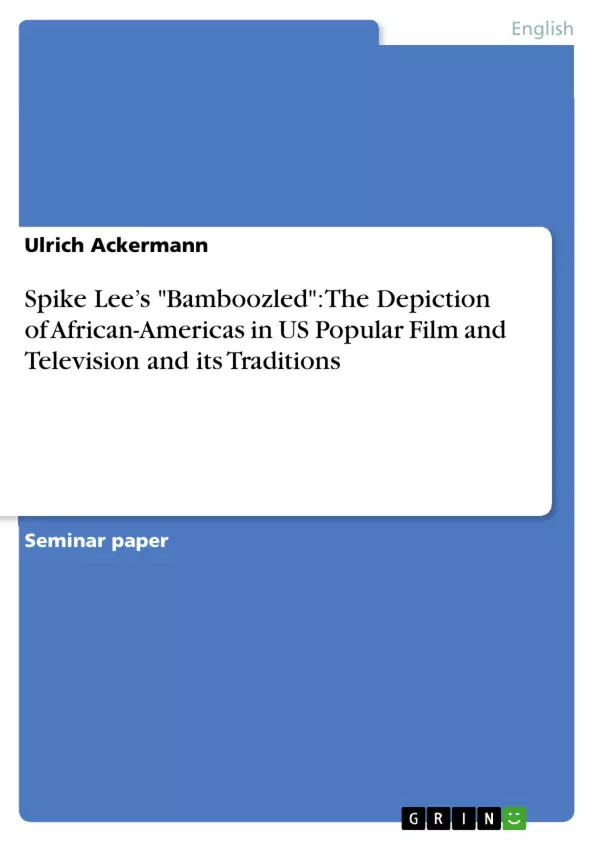Throughout their history in the United States, African–Americans had never been in charge of their own image.
When in Kentucky in 1928, Thomas "Daddy" Rice, a white man who performed in black-face "Jim Crow", a song that he had heard before in the South from a black performer, a new genre was born: the minstrel show, a white imitation of black culture.
In his movie Bamboozled (2000), Spike Lee confronts us with the question, if these racist nineteenth century depictions of African Americans still exist today in contemporary popular media. In this case we have to ask the question of responsibility for these representations: In the 1990s 340 billion dollars had been spent on media and entertainment in the United States. The entertainment industry today has become the fastest increasing factor of economy. Since the 1970s television is the largest and most influential entertainment medium in North America and occupies a crucial space in practices of everyday life, "where important social encounters and cultural transformations are possible." The concept of ‘seeing is believing’ obviously is a major factor here." A majority of Americans only came to know and understand the American racial order through media representations of the black ethnic other.
This research paper will try to give some proof of the historical continuity of the stereotypical racist representations of
African Americans from the days of minstrelsy and vaudeville until today.
Inhaltsverzeichnis (Table of Contents)
- Introduction
- I Bert Williams and George Walker: black entertainers in blackface
- II Today's situation of the black underclass
- III The Huxleys: black upper middle-class family with dignity
- IV Mantan Moreland: the man with the fastest eyes in the West
- V Gangster Rap and the Hood movies
- VI In Living Color: the satirical black point of view
- VII The slave as an entertainer
- VIII The traditional stereotypes
- IX Power structures in the entertainment industry
- X The Minstrel scenes and the ‘Old South Myth'
- Conclusion
Zielsetzung und Themenschwerpunkte (Objectives and Key Themes)
This research paper examines the depiction of African Americans in US popular film and television, particularly focusing on Spike Lee's film "Bamboozled" (2000). The objective is to explore the historical continuity of stereotypical racist representations of African Americans, from the days of minstrelsy to contemporary media. Key themes include:- The historical evolution of stereotypical representations of African Americans in entertainment media.
- The persistence of racist depictions in contemporary film and television.
- The power structures and dynamics within the entertainment industry that perpetuate these stereotypes.
- The impact of media representations on perceptions of race and ethnicity.
- The role of black entertainers in shaping and challenging these representations.
Zusammenfassung der Kapitel (Chapter Summaries)
- The introduction establishes the research context, discussing the historical lack of control African Americans had over their own image and the impact of media on societal perceptions. It introduces the film "Bamboozled" as a lens to examine these issues.
- Chapter I delves into the early 20th-century situation of black entertainers, specifically focusing on Bert Williams and George Walker, highlighting their experiences performing in blackface.
- Chapter II provides a brief overview of the socio-economic conditions of the black underclass in contemporary society.
- Chapter III explores the representation of the African American middle-class, using "The Cosby Show" as an example.
- Chapter IV focuses on the 1930s and 1940s models for minstrel actors, examining figures like Mantan Moreland, Willie Best, Stepin Fetchit, and Bill 'Bojangles' Robinson.
- Chapters V and VI analyze contemporary forms of film and television that present the African American perspective on their own race, particularly examining the "Hood movies" genre and the sitcom "In Living Color."
- Chapters VII and VIII delve into the historical expectation of African Americans as entertainers and the traditional stereotypes associated with them.
- Chapter IX investigates the interracial power structures within the modern entertainment industry.
- Chapter X examines the transformation of the "Old South Myth" into contemporary media representations of African Americans.
Schlüsselwörter (Keywords)
This research examines the representation of African Americans in US popular film and television. Key terms and concepts include "Bamboozled," "minstrelsy," "blackface," "stereotypes," "representation," "power structures," "entertainment industry," "African American culture," "race," "ethnicity," and "media."- Quote paper
- Ulrich Ackermann (Author), 2007, Spike Lee’s "Bamboozled": The Depiction of African-Americas in US Popular Film and Television and its Traditions, Munich, GRIN Verlag, https://www.grin.com/document/144965



